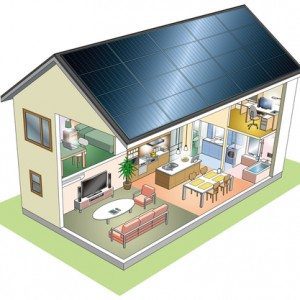
Are you interested in getting discounts on your solar energy system and storage? XCEL’s Solar Rewards program is now offering significant discounts for Income qualified and disproportionately impacted communities program for both solar systems and energy storage systems.
The Program:
For batteries, Xcel will pay for $800 per kW of equipment installed, or up to 80% of the equipment cost. In combination with the
30% federal tax credit, our customers are saving over 80% of the installed cost to add batteries to their solar system.
Xcel also has a program for solar energy systems without batteries that is expected to reopen in 2025. This program offers a discount of one dollar per watt installed for systems up to 7 kW. This means a discount up to 7000$ dollars! This utility rebate could cover over a quarter of total costs in addition to the federal 30% tax credit.
The
IQ/DIC program (Income Qualified or Disproportionately Impacted Community) is meant to offer access to clean renewable energy for both households that meet income requirements and communities that are most impacted by environmental health and social justice issues.
How to Qualify:
For the IQ/DIC program, customers must meet one of following criteria:
-
- The median household income is less than two times the federal poverty guideline
- The median household income is less than 80% of the area’s median income
- The customer may qualify under the income guidelines of Section 40-8.5-105, C.R.S. adopted by the Department of Human Services
- Live in a DIC community
The Disproportionately Impacted Communities criteria are defined by
Colorado EnviroScreen: an environmental justice mapping tool. This program was developed for
the Colorado Department of Public Health. The map identifies geographic areas with poor quality of air and water, vulnerability to natural disasters increased by climate change, in close proximity to heavily polluting industries, and higher prevalence of certain diseases likely impacted by these factors.
To find out if you reside in a disproportionately impacted community, you can use the
EnviroScreen mapping tool. All addresses located in areas with an EnviroScreen score in the top 20 percent are eligible for these discounts. You can simply type in your address and check if you live in an area with diagonal lines on the map. A significant portion of Xcel territory falls within these areas.
The average American
contributes an estimated 17 to 21.5 metric tons (around 40,000 pounds) of carbon dioxide in greenhouse gas emissions each year. This amount is known as the “carbon footprint.” Reducing your carbon footprint not only minimizes your personal contribution to climate change, doing so usually saves you money as well. You can estimate your own carbon footprint with the use of
online calculators that account for location, type of housing and activities such as home heating and recycling. Minimize this footprint by taking some or all of the following steps around your home:
- Insulate your home. Seal air leaks and reduce drafts with caulk, insulation, and weather stripping around doors and windows.
- Appliances. Replace old appliances such as furnaces, washing machines, dryers, dishwashers, water heaters and refrigerators with energy efficient models. The ENERGY STAR label indicates products certified to have superior efficiency.
- Lighting. When you leave a room, turn off lights. Replace incandescent light bulbs with more efficient lighting, such as LED bulbs, which use up to 80 percent less energy and last longer.
- Thermostat. Install a programmable thermostat that will turn off heating or air conditioning when you are not home.
- Laundry. Wash clothes in cold water and line dry outside in warmer months.
- Hot water. Insulate your water heater for more efficient operation. Lower its temperature a few degrees also. Take shorter showers at lower temperatures.
- Recycle. You could save 582 pounds of carbon dioxide annually by recycling your household’s glass, aluminum, plastic, and paper, according to estimates by the U.S. Environmental Protection Agency. That’s the equivalent carbon dioxide that would be emitted by more than 600 miles of driving.
- Solar. Install solar panels on your roof. Photovoltaic panels capture the free, clean and renewable energy from the sun and convert that energy to electricity. Many providers offer financing options, several states provide incentives for installation, and if you live in a state with a Net Metering law, you could possibly eliminate your electricity bill and potentially earn money from selling excess electricity back to your local power company. If all of the electricity used by the average American home is generated through solar power instead of conventional fossil fuels, that home would emit 6.7 metric tons of carbon dioxide less each year.
The post
Ways to Cut Your Home’s Carbon Footprint (Tips for Greener Living Series) appeared first on
Golden Solar.

Who doesn’t want to contribute to a clean planet? Since the “Save the Planet” phase decades ago, the idea has morphed into a solid part of our global way of life. Solar panels on someone’s roof aren’t a novelty anymore; they have become everyday sightings.
Why Green Living?
So, are we really pulling off this “green living” thing? With the help of the solar panel industry, which is constantly innovating and improving, pulling energy from the sun to power our homes is not only possible but is becoming more commonplace and affordable.
The average household in the United States uses around 901 kilowatt hours of electricity per month, according to the
US Energy Information Administration. We also use an average of about 400 gallons of water a day, some of it heated. If your home functions from a green point of view, installing at least some of the current technologies can make life so much easier.
Green Technology for the Home
Technology is a beautiful thing. Whether you’re into green living 1000 percent or you just want to dabble a bit here and there, there’s an
array of technological devices available to help you make your home more eco-friendly.
- Solar Panel Array. Today’s solar panels aren’t the monstrosities that haunted our rooftops in the 1970s. Modern solar panels are efficient and compact and can fit seamlessly into your home’s aesthetic.
- Solar Hot Water Heater. A conventional water heater uses natural gas or electricity to heat the water for your morning shower. If you’re pulling power off the grid, that’s money down the drain. A solar hot water heater can use energy collected from your solar panels to heat the water you need.
- Rain Barrels. Whether you’re growing flowers for decoration or food for the family table, you’re not growing much without watering. For outdoor water use, a rain barrel or two makes for a fantastic irrigation system that doesn’t cost you to refill.
- Backyard Wind Turbine. If you live in an area where wind turbines are feasible, having one in your backyard can supplement your solar panels as your home’s energy source.
- Programmable Thermostat. Not only are programmable thermostats economically a good idea, they can make controlling your home’s internal temperature a stress-free affair. You can set it to control your home’s HVAC to the settings your family prefers. This can stretch your solar energy even further.
Technology is a beautiful thing, and a useful tool around the house. The sun’s going to shine on your home anyway; make the most of it with an
array of solar panels to power your home.
The post
5 Technologies That Make Green Living Easy appeared first on
Golden Solar.
 Going off the electrical grid can begin as an environmental or political ideal, but in practical terms, 2017 is the year to turn ideas into reality. For those brave pioneers who tried to free themselves from utility companies in years past, the available options today will seem like Utopia. While many details must be considered, your off-grid power plan needs two major components: the photovoltaic (PV) panels and the storage batteries.
Going off the electrical grid can begin as an environmental or political ideal, but in practical terms, 2017 is the year to turn ideas into reality. For those brave pioneers who tried to free themselves from utility companies in years past, the available options today will seem like Utopia. While many details must be considered, your off-grid power plan needs two major components: the photovoltaic (PV) panels and the storage batteries.
Plan
When deciding to make the leap to off-grid power, plan carefully. Calculate your power consumption needs, how many PV panels you will need to meet those needs and how many batteries (and of what type) you will require to store power for sunless days and overnight use. The first consideration is how long you expect batteries to sustain you and your family:
- Overnight and cloudy days?
- Through a snowstorm of three or four days?
A 24-volt battery bank could help you along through overnight or morning cloud cover, but if you are hoping to stretch batteries out to three or four days, you will need greater capacity.
You can find load calculators online. Take into account future growth in your family, so if now you have adorable toddlers, you can plan to have enough electricity to meet the needs of power-hungry teens.
The power consumption calculation guides you to battery selection. You have many choices in solar batteries these days, and prices are falling:
- Tesla Powerwall — using lithium-ion batteries for maximum efficiency
- Iron Edison — using nickel-iron batteries
- Adara — lithium-ion energy storage systems
Plan carefully, because batteries are still expensive, though environmentally far friendlier than using a gasoline-powered generator to keep the lights on when the sun is off duty.
Solar storage batteries work best when kept warm (80 ℉), so if you know you are going off-grid for your mountainside winter vacation home, expect to need more batteries than if you were planning an oceanfront installation for summers only.
PV Panels
PV panels can power your home’s entire ongoing needs and are the source for power storage sent to the backup batteries. In off-grid systems, the PV panels need to maximize energy collection, so you may find that rooftop panels are only a start. You may want to consider additional ground or pole mounts, or even panels that can rotate to capture as much sunlight through the day as possible.
Solar Charge Controller
Getting the power from the PV panels to the batteries requires a solar charge controller. The controller acts as a sort of one-way valve, preventing battery power from running out to the panels on cloudy days and keeping the batteries fully charged by the panels during sunny days.
A solar charge controller can either be a Maximum Power Point Tracking (MPPT) or Pulse Width Modulated (PWM) controller. The MPPT is superior, but more costly since it matches PV panel output to the battery bank’s capacity. A PWM controller is the more traditional, less expensive, solution.
Batteries
Though called “solar batteries,” the technology behind power storage is not exclusive to solar energy. All batteries store and deliver power as Direct Current (DC), rather than the Alternating Current (AC) our everyday appliances, computers, and devices demand. This means the flow is not directly from batteries into your home; you need an inverter, or possibly even two.
North American electrical current is 240 volts that are stepped down to 120 volts; some appliances (a stove, a clothes dryer) may use 240-volt AC, while everything else in your home requires 120-volt power. While some inverters can be ganged to provide 240 volts, you may find a simpler solution by creating two separate power feeds from the batteries.
Professional Partner
Before embarking on an exciting adventure in off-grid living, partner with seasoned solar professionals. Contact Golden Solar today to learn more about the many facets of off-grid solar power. You can avoid costly mistakes by tapping the knowledge and experience of the experts at Golden Solar.
The post
Off-Grid Freedom Is Yours appeared first on
Golden Solar.



 Who doesn’t want to contribute to a clean planet? Since the “Save the Planet” phase decades ago, the idea has morphed into a solid part of our global way of life. Solar panels on someone’s roof aren’t a novelty anymore; they have become everyday sightings.
Who doesn’t want to contribute to a clean planet? Since the “Save the Planet” phase decades ago, the idea has morphed into a solid part of our global way of life. Solar panels on someone’s roof aren’t a novelty anymore; they have become everyday sightings.
 Going off the electrical grid can begin as an environmental or political ideal, but in practical terms, 2017 is the year to turn ideas into reality. For those brave pioneers who tried to free themselves from utility companies in years past, the available options today will seem like Utopia. While many details must be considered, your off-grid power plan needs two major components: the photovoltaic (PV) panels and the storage batteries.
Going off the electrical grid can begin as an environmental or political ideal, but in practical terms, 2017 is the year to turn ideas into reality. For those brave pioneers who tried to free themselves from utility companies in years past, the available options today will seem like Utopia. While many details must be considered, your off-grid power plan needs two major components: the photovoltaic (PV) panels and the storage batteries.








